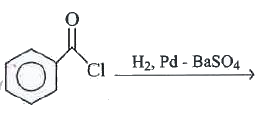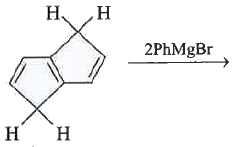Which of the following reaction gives by isocyanide
Rimer Tieman reaction
Carbyl amine reaction
Hoffmann bromamide reaction
None of the above
The correct Answer is:B
To determine which reaction gives isocyanide, we can analyze the options provided in the question.
1. Identify the Reactions: We have four reactions to consider:
- Riemann-Tiemann Reaction
- Carbylamine Reaction
- Hofmann-Bromamide Reaction
2. Analyze the Riemann-Tiemann Reaction:
- This reaction involves the reaction of phenol with chloroform in the presence of a base to produce salicylaldehyde.
- Conclusion: This reaction does not produce isocyanide.
3. Analyze the Carbylamine Reaction:
- This reaction involves the reaction of a primary amine (e.g., ethyl amine) with chloroform and a base, leading to the formation of isocyanide (in this case, ethyl isocyanate) along with the release of KCl and H2.
- Conclusion: This reaction produces isocyanide.
4. Analyze the Hofmann-Bromamide Reaction:
- In this reaction, an amide (e.g., ethane amide) reacts with bromine and a base to yield a primary amine, along with KBr and water as byproducts.
- Conclusion: This reaction does not produce isocyanide.
5. Final Conclusion:
- Among the reactions analyzed, the Carbylamine reaction is the only one that produces isocyanide. Therefore, the correct answer is the Carbylamine reaction.
Answer:
The reaction that gives isocyanide is the Carbylamine Reaction.
- Riemann-Tiemann Reaction
- Carbylamine Reaction
- Hofmann-Bromamide Reaction
- This reaction involves the reaction of phenol with chloroform in the presence of a base to produce salicylaldehyde.
- Conclusion: This reaction does not produce isocyanide.
- This reaction involves the reaction of a primary amine (e.g., ethyl amine) with chloroform and a base, leading to the formation of isocyanide (in this case, ethyl isocyanate) along with the release of KCl and H2.
- Conclusion: This reaction produces isocyanide.
- In this reaction, an amide (e.g., ethane amide) reacts with bromine and a base to yield a primary amine, along with KBr and water as byproducts.
- Conclusion: This reaction does not produce isocyanide.
- Among the reactions analyzed, the Carbylamine reaction is the only one that produces isocyanide. Therefore, the correct answer is the Carbylamine reaction.
The reaction that gives isocyanide is the Carbylamine Reaction.
Similar Questions
Knowledge Check
Which of the following reaction may give benzaldehdye ?
A B
B C
C D
D
Which of the following reactions give alkylation product ?
A B
B C
C D
D
Which of the following reactions give aromatic ion ?
A B
B C
C D
D
Which of the following reactions give alkylation product :
View SolutionWhich of the following reactions will give alkyne?
View SolutionWhich of the following compounds will give isocyanide on reaction
with CHCl3+KOH ?
View SolutionWhich of the following reactions will give alkyne?
View SolutionWhich of the following reactions will give identical products ?
View Solution